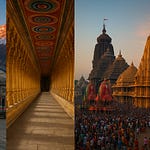Location: Mandhata Island, Khandwa District, Madhya Pradesh
River: Narmada
Significance: One of the 12 Jyotirlingas of Lord Shiva
🌄 Introduction: Where Divinity Breathes in Every Stone and Wave
Omkareshwar is not just a place—it is a living, breathing embodiment of spirituality. Nestled amidst the tranquil flow of the sacred Narmada River, the island shaped like the divine symbol “ॐ” is home to Omkareshwar Jyotirlinga, one of the twelve most revered abodes of Lord Shiva. Here, the roaring silence of ancient stones meets the eternal hymn of flowing water, making it a sacred geography where heaven meets earth.
🕉️ Historical and Mythological Significance
The story of Omkareshwar is woven into the very fabric of India’s mythological and spiritual heritage.
According to the Skanda Purana, Shiva Purana, and other ancient scriptures, Omkareshwar became a Jyotirlinga after a great celestial event. It is said that the Devas (gods) were once defeated by the Asuras (demons). Seeking help, the Devas worshipped Lord Shiva with unwavering devotion on the banks of the Narmada. Pleased by their prayers, Shiva manifested in his Omkaara form, signifying the ultimate sound of creation, preservation, and dissolution—“ॐ”—and vanquished the Asuras. This form of Shiva came to be known as Omkareshwar.
Another prominent legend attributes the sanctity of the island to King Mandhata, a devout ruler of the Ikshvaku dynasty, who performed intense penance here. So powerful was his tapasya (austerity) that Lord Shiva appeared and blessed the land with his eternal presence in the form of a Jyotirlinga. This is why the island is also called Mandhata Parvat.
The most remarkable geographical aspect is that the island itself naturally resembles the sacred syllable “ॐ” when viewed from above, reinforcing the spiritual energy and sanctity associated with the location.
🛕 The Temple and Its Sacred Architecture
The Omkareshwar Temple is constructed in the Nagara style of architecture, with beautifully carved pillars, mandapas (halls), and shikharas (spires). The sanctum sanctorum houses a swayambhu (self-manifested) Shivalinga, considered to be eternally radiant and spiritually potent.
Interestingly, Omkareshwar is unique because it is said to house two Jyotirlingas—Omkareshwar and Amareshwar. Some traditions consider both as twin Jyotirlingas. While Omkareshwar resides on the island, Amareshwar is situated on the southern bank of the Narmada River and is also revered by devotees with equal devotion.
🔱 Rituals, Worship, and Daily Practices
The daily rituals at Omkareshwar Temple begin before dawn and extend late into the night. Each day, the Shivalinga is bathed with holy Narmada water, milk, ghee, honey, and offered bilva leaves, flowers, sandalwood paste, and sacred ash.
Devotees chant "Om Namah Shivaya", perform Abhishekam (ritualistic bathing), and offer deepas (lamps) while circumambulating the sanctum. The spiritual rhythm of temple bells, the fragrance of incense, and the continuous chanting create a deeply meditative environment.
Special pujas like Rudrabhishek, Laghu Rudra, Maha Mrityunjaya Jaap, and Parthiv Shivling Puja are conducted upon request and during major festivals.
In the evening, the temple resonates with the divine during the Sandhya Aarti, while the nearby Narmada ghats host a mesmerizing river Aarti, where hundreds of oil lamps float along the currents, symbolizing the surrender of human ego to divine grace.
🌸 Spiritual Importance and Pilgrimage Essence
Omkareshwar is not just a pilgrimage; it is an inner journey of awakening. Considered the vibrational heart chakra among the Jyotirlingas, the site is revered for its power to align one's spiritual energy. Thousands of yogis, saints, and seekers have meditated here over the centuries, believing it to be a gateway to moksha (liberation).
The Narmada River, which flows with gentle force around the temple, is seen as a living goddess—Maa Narmada. It is believed that even a glimpse of this river can cleanse lifetimes of sins. Unlike the Ganga and Yamuna, where the spiritual power comes from immersion, Narmada bestows blessings just through darshan (sight).
🙏 Festivals and Celebrations
The spiritual vibrancy of Omkareshwar reaches its zenith during major festivals. Each celebration transforms the temple and the ghats into centers of divine ecstasy and collective devotion.
Maha Shivaratri
This is the most important festival at Omkareshwar. Devotees fast, chant mantras all night, and participate in elaborate pujas and processions. The temple remains open for 24 hours and is adorned with flowers and lights. Devotees believe that witnessing the Ratri Jagran and Mahabhishek on this night brings immeasurable blessings.
Shravan Maas (July–August)
The entire month is dedicated to Lord Shiva. Pilgrims carry water from the Narmada and walk barefoot to the temple, offering it to the Jyotirlinga. This ritual, known as Kanwar Yatra, draws thousands from all across India.
Narmada Jayanti
Celebrated on the banks of the river, this festival honors the divine origin of Maa Narmada. Devotees take holy dips, conduct pujas on the ghats, and participate in cultural events and devotional singing.
Other significant festivals include Guru Purnima, Kartik Purnima, Diwali, and Navratri, all observed with spiritual grandeur and traditional rituals.
🚶♂️ The Narmada Parikrama: A Spiritual Journey of a Lifetime
One of the most spiritually intense pilgrimages in India is the Narmada Parikrama—a circumambulation of the entire Narmada River, spanning nearly 2,600 kilometers along both banks.
Omkareshwar is a major halting and beginning point for many Parikramavasis (pilgrims performing the parikrama). A smaller 7-kilometer Omkareshwar Parikrama Path around the island is also undertaken by devotees. This sacred circuit passes through ancient temples, caves where rishis meditated, and scenic viewpoints, with the Narmada river constantly by your side.
🧭 How to Reach Omkareshwar
Omkareshwar is well-connected and accessible via multiple modes of transport.
By Air: The nearest airport is Indore (about 77 km away), which is connected to major Indian cities.
By Rail: The closest railway station is Omkareshwar Road (12 km), with better connectivity through Khandwa Junction.
By Road: Buses and taxis are available from Indore, Ujjain, and Khandwa. The roads are scenic and take you through the heart of Madhya Pradesh’s cultural landscape.
🕰️ Temple Timings and Best Time to Visit
The temple is open daily from 5:00 AM to 10:00 PM.
The Mangala Aarti (morning) starts around 5:30 AM and Sandhya Aarti (evening) is around 7:00 PM.
The best time to visit is between October to March, when the weather is pleasant, especially during Shivaratri and the winter season.
🛏️ Accommodation and Amenities
Pilgrims have a wide range of accommodation options, from ashrams and dharamshalas to budget hotels and river-view resorts. The temple trust also operates guest houses with basic amenities.
Local eateries serve pure vegetarian meals, and during festivals, community kitchens (bhandaras) provide free food to thousands of pilgrims.
🧘 The Experience: Stillness, Surrender, and Liberation
Sitting by the Narmada, with the gentle breeze whispering ancient mantras, and the temple bells echoing in the distance—the entire atmosphere feels timeless. Omkareshwar is a place where you do not just visit Shiva, you feel Him. The presence is palpable, the energy healing, and the silence transformative.
Whether you are a seeker, devotee, traveler, or explorer, a visit to Omkareshwar Jyotirlinga and the banks of the Narmada is not a journey—it is a soul encounter. One that lingers far beyond the physical space and transforms the inner realm.
🕉️
In the ever-changing flow of life, Omkareshwar and Maa Narmada remain eternal—a testimony to the unbroken tradition of faith, devotion, and inner awakening. This sacred island is a bridge between the mortal and the divine, a reminder that within the “Om” lies the entire universe, and within its echo, the ultimate peace.










